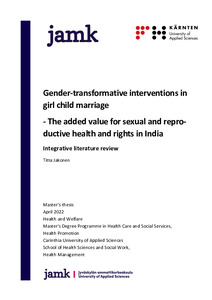Gender-transformative interventions in girl child marriage - The added value for sexual and reproductive health and rights in India : Integrative literature review
Jakonen, Titta (2022)
Jakonen, Titta
2022
Julkaisun pysyvä osoite on
https://urn.fi/URN:NBN:fi:amk-2022061518009
https://urn.fi/URN:NBN:fi:amk-2022061518009
Tiivistelmä
Child marriage prevalence has tremendously declined in India during the past decades. However, the challenge remains significant in certain parts of the country. Gender norms and power relations are among the main reasons behind child marriage practice in the country. Child marriage violates human rights and severely threatens girls’ prospects. Child marriage also has serious and often lifelong effects on girls’ sexual and reproductive health and rights (SRHR) both at individual and population level. The aim of the study was to enhance the applicability of gender-transformative interventions (GTIs) for adolescent girls’ sexual and reproductive health and rights promotion in the context of girl child marriage. The purpose of the study is to identify the strategies in girl child marriage prevention related GTIs operating at individual, interpersonal and community levels conducted in India. The methodology of the study was an integrative review, and the data were analysed using the thematic analysis method. Seven (7) main strategies were recognised in gender transformative child marriage prevention: safe space for girls, strategic communication, facilitating the process, empowerment, stakeholder engagement, reference groups, and sensitisation. All the interventions utilised multipronged approach with several different strategies. In conclusion, it was suggested that child marriage preventive GTIs have a potential for SRHR promotion in the context of girl child marriage in India. These interventions could improve SRHR of girls by eliminating the harmful consequences of child marriage. In addition, the gender transformative approach in child marriage prevention could offer a positive viewpoint to female sexuality and reproduction and enable better fulfilment of girls’ overall SRHR.
